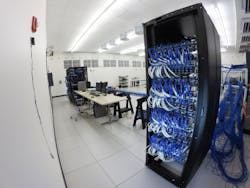Panduit: PoE standards are overly conservative; in real world, bigger bundles are practical
Results of testing conducted at Panduit labs indicate that today’s cabling standards governing Power over Ethernet are overly conservative, Panduit recently announced. “The first-of-its-kind testing was a joint effort of Panduit, Cisco, and Philips Lighting,” Panduit said. “This was the first real-world PoE test case, where power and data were transmitted over 192 cables of varying lengths, with temperature rise measured at the center of the 192-cable bundle. This enhanced test method produces more-accurate results by taking into account the constant-power nature of PoE.”
The three companies presented their findings in multiple venues, including a recent meeting of the Institute of Electrical and Electronics Engineers (IEEE) 802.3 Working Group and at a workshop held during BICSI’s Fall Conference.
Panduit summed up the findings with two high-level statements.
- Real-world worst-case PoE deployment scenarios have lower temperature rise than the previous worst-case models.
- PoE cable bundles can be larger than current standards recommend.
The testing focused on constant current versus constant power. As Panduit explained, “Some of today’s standards are built around constant current models—delivering the same worst-case level of current through the channel regardless of channel length. Conversely, constant power model reflects the actual IEEE PoE standard, which limits powered devices to a maximum wattage regardless of the cable length. The implication of constant power is that with shorter channels, less power and current is delivered from the source, due to the lower power losses over the channel, than in the constant current models.
“The Panduit laboratory setup, which utilized 29,000 feet of cable, was designed with varying lengths of cable to represent a typical setup of enterprise cabling length distribution. The power at the source was then modified to ensure that the power at the end device was held constant. Additionally, to ensure the quality of transmission during the testing, a bit error rate generator was used to transport data across the cabling.”
Panduit, Cisco, and Philips Lighting jointly recommend that standards bodies refer to the constant power methodology in generating best practices.
Ron Nordin (pictured, top), director of research for Panduit, commented, “We plan to work with the National Fire Protection Agency (NFPA) to provide better guidelines for the delivery of power over LAN cabling and installation best practices.” In the 2017 edition of the National Electrical Code, the NFPA enacted specifications governing the installation of cabling delivering remote power.

